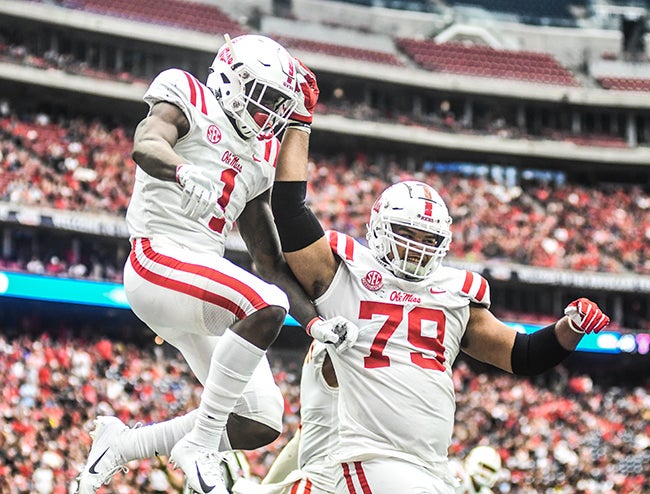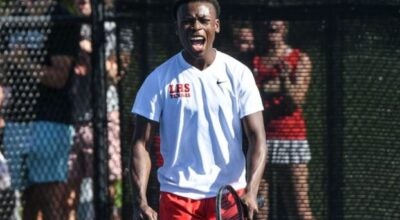Season wrap: Examining the Ole Miss football season though an advanced statistical lens
Published 1:46 pm Monday, December 10, 2018

- Ole MIss' A.J. Brown (1) and Javon Patterson (79) celebrate Brown's touchdown vs. Texas Tech at NRG Stadium in Houston, Texas on Saturday, September 1, 2018. Ole Miss won 47-27. (Bruce Newman, Oxford Eagle via AP)
It wasn’t’ exactly the prettiest season for football. Regression in the second season of a coaching staff’s era is not expected or particularly a good sign. At 5-7 on the season, the Rebels won just one game in the Southeastern Conference, but there are some positive marks.
Ole Miss was one of the most explosive offenses in the country, and the defense was downright miserable. But in an age of analytical supremacy in sport, there are other ways to more closely look at a team. With the season wrapped up, we looked at two advanced college football metrics to see what we could learn about Ole Miss’ success and shortcomings from a deeper, statistical perspective.
Metric 1: S&P+
S&P+ is a metric designed by Bill Connelly to “analyze tendencies, break down matchups, and home in as closely as possible on a team’s true strengths, assets, and liabilities.” The algorithm for S&P+ takes into account a plethora of factors, but the five major pillars are efficiency, explosiveness, field position, finishing drives and turnovers.
By S&P+, Ole Miss ranked as an extremely average football team. At 70th in the nation, the Rebels scored an S&P+ rating of +1.3, meaning they would be 1.3 points better per game, on a neutral field, than an average FBS college football team.
Offensively, Ole Miss scored very well, ranking 12th nationally. That was down a bit from standard ranks, such as Ole Miss’ 9th national ranking in yards per game. Most of the offense numbers are what you expect – the team was better in between the 20s and struggled in the red zone, as is well documented – but there’s the one that stands out. Ole Miss ranked 122nd in the country in adjusted run rate.
Essentially, out of 130 FBS teams, Ole Miss was 8th from the bottom in rushes on standard downs (defined as plays that aren’t obvious passing situations – ex. 3rd and 5+). This number really shows the personality and predictability of offensive coordinator and play-caller Phil Longo. When passing becomes that predictable, it’s easy for a defense to prepare for what’s coming.
The Ole Miss defense isn’t great; this is also not a surprise. They ranked 109th of 130 in defense, and what stands out is there really isn’t anything the unit did well. Against the run, they ranked 112th. Against the pass, they ranked 97th, both considerably worse marks than the next worse SEC defense. The firing of Wesley McGriff came as a surprise to no one. This unit lacks an identity, and that should be one of the first steps for new defensive coordinator Mike MacIntyre.
Metric 2: FEI Ratings
The Fremeau Efficiency Index (FEI) is a Football Outsiders system created by Brian C. Fremeau. Defined as a “college football rating system based on opponent-adjusted possession efficiency,” FEI is essentially another efficiency rating. It measures how good at team is at scoring while in possession of the football and how good a team is at preventing scores while not in possession of the football.
Like with S&P+, Ole Miss rated out shocking average: 70th in the nation yet again. They scored at -0.006, meaning they were 0.6% worse than the FBS average football team. For the record, there were two SEC teams worse than Ole Miss, by FEI: Tennessee at 84 and Arkansas at 100. By offense, Ole Miss rated 16th. Defensively, they rated out 106th.
There were a few interesting things to glean from FEI about the Rebel season. Offensively, while they rated 16th in the nation, they were 60th in touchdown rate and 84th in touchdown after first round rate. Of the teams in the top-20 offensively, Ole Miss was hands down the worst at these two categories. Ultimately, it points out how inefficient the Rebel offense was at turning yards gained into points.
In the end, the numbers do nothing more than elucidate problem areas within the Ole Miss team. Numbers can’t solve schematic flaws or personnel issues, but when used properly they can show where things can improve.





